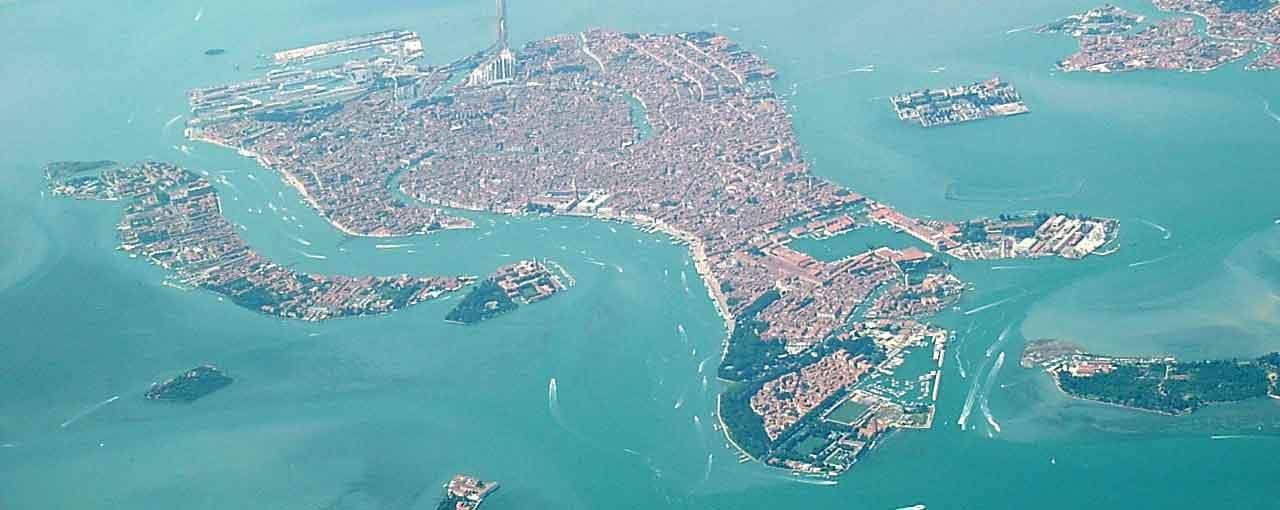Geography of Venice
Venice is a unique and enchanting destination that has captivated travellers for centuries. This city Venice in Italy is situated in the northeastern part of Italy. The city is famous for its intricate network of canals. Venice's geography plays a pivotal role in shaping its identity and allure.
Location and Formation of Venice
Venice is nestled within the Venetian Lagoon. This is an enclosed bay in the Adriatic Sea, part of Italy's Veneto region. The historic centre of Venice is divided into six ancient administrative districts. These are known as 'sestieri' (singular - 'sestiere').
The city also has 118 small islands. A complex network of canals and bridges interconnects these islands. Some of these islands belong to sestieri. For example, the island of Giudecca belongs to Dorsoduro. Again San Giorgio Maggiore, the cemetery island, belongs to the sestiere of San Marco. Also, some islands are organised into sestieri, for example, Burano has 5 sestieri. The Sestiere can be considered an Italian district. A long barrier island known as the Lido protects the lagoon. The Lido acts as a natural buffer against the open sea and helps shelter the city from storm surges.
Each of the Venice sestieres has its own distinct character and historical significance. The six sestieri of Venice are:
San Marco: is located in the heart of Venice. San Marco is home to the famous St. Mark's Square (Piazza San Marco) and the impressive St. Mark's Basilica. Since ancient times, this sestiere is the cultural and political centre of Venice. Read more about San Marco.
Castello: Positioned to the east of San Marco. Castello is one of the largest and most diverse sestieri in Venice. It encompasses the Arsenal, the former shipyard that played a vital role in Venice's maritime history. Read more about Castello.
Cannaregio: Located to the north of the Grand Canal. Cannaregio is a lively and vibrant sestiere. It is less touristy compared to some other districts, offering a glimpse into authentic Venetian life. The Jewish Ghetto, one of the oldest in the world, is also situated in Cannaregio. Read more about Cannaregio.
Dorsoduro: Situated to the south of the Grand Canal. Dorsoduro is known for its art and educational institutions. It houses the Gallerie dell'Accademia and the Peggy Guggenheim Collection. These galleries display an exceptional collection of Venetian art and modern art masterpieces. Dorsoduro exudes a bohemian atmosphere and is a favourite among students and artists. Read more about Dorsoduro.
San Polo: Located in the western part of the city. San Polo is known for its bustling marketplaces, such as the Rialto Market. The Rialto Bridge, one of the most famous bridges in Venice, connects San Polo with San Marco. This sestiere offers a mix of traditional Venetian charm and lively commercial activity. Read more about San Polo.
Santa Croce: Situated near the main entrance to Venice. Santa Croce is the smallest and least densely populated sestiere. It is primarily a residential area with narrow streets and picturesque canals. The Piazzale Roma, the main terminal for buses and cars entering the city, is located in Santa Croce. Read more about Santa Croce.
Each of these sestieri contributes to the unique tapestry that is Venice. Together they showcase the city's rich history, architectural splendour, and vibrant cultural scene.
Canals and Waterways:
Keep in mind that getting around Venice is not that easy and takes time to settle in. There are no buses or taxis in Venice but waterbuses and water taxis. The canals of Venice are the lifeblood of the city. These are serving as its primary transportation system. The Grand Canal is the largest and most important waterway. It, meanders through the heart of the city, dividing it into two parts. Numerous smaller canals crisscross the city, creating a labyrinthine network that connects various islands and neighbourhoods. The canals are spanned by over 400 bridges, each contributing to the city's picturesque charm.
Challenges of Living on Water:
Living on water has its challenges, and Venice is no exception. The city is susceptible to high tides, known as acqua alta, which can lead to flooding in the low-lying areas. During these occurrences, raised wooden walkways, known as "catwalks," are deployed to help residents and visitors navigate the flooded streets. Over the years, Venice has implemented various engineering solutions to combat the impact of rising water levels.
Additionally, the constant exposure to water and moisture poses a threat to the city's historic buildings and infrastructure. Maintenance and restoration efforts are ongoing to protect these invaluable landmarks from degradation.
Venice's geography is undeniably central to its identity as the "Floating City." Its canals, beautiful bridges, and historic architecture create an awesome experience for visitors. While the city faces unique challenges associated with its location on the water, it continues to enchant the world with its timeless beauty and rich cultural heritage.






